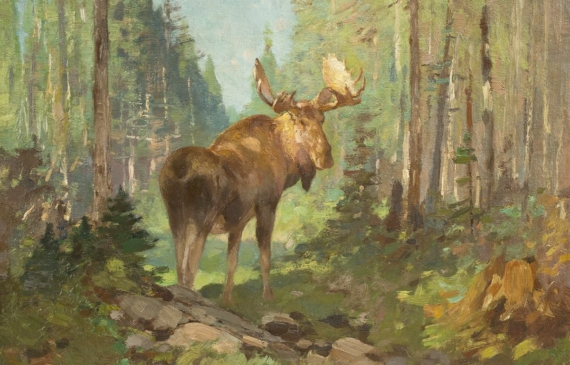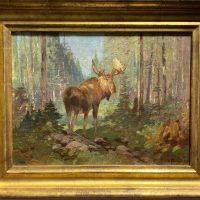

Carl Rungius (American, 1869-1959)
Woodland Moose, circa 1915
Oil on canvas
12 H. x 16 W. inches
Signed lower right: C. Rungius
Provenance:
The Estate of Rosalie Coe Weir
Carl Rungius is considered by many art historians to be the greatest wildlife painter of the western wilderness because of his ability to study the animals and landscape so closely and to paint them with skill and understanding.
His father and grandfather were amateur naturalists in their native Germany, and Rungius studied wildlife painting at the Berlin Academy. In 1894, he received an invitation from relatives to come to America for a moose-hunting expedition in Maine. He stayed afterwards, settling in New York, and developed a career for the next ten years as a wildlife illustrator for a variety of outdoor magazines.
In 1895, he journeyed to the Rocky Mountains to a ranch at the foot of the Wind River chain in Wyoming. He hunted and sketched profusely for five months, traveling as far as Jackson Hole and the Yellowstone country. Returning to New York, he adorned his studio with his trophies and determined to stay in America.
Rungius returned to Wyoming in successive years, and in 1904 accompanied a scientific expedition into Canada’s Yukon Territory where he studied high mountain sheep. Back in New York, he became a popular and well-respected artist, and regularly exhibited his work to high acclaim. “There is not likely to be another fellow who will have the opportunity to study big game as you are doing,” Frederic Remington wrote him admiringly, “and I think records of us fellows who are doing the ‘Old America’ which is so fast passing will have an audience in posterity.”
In 1910, responding to another invitation, Rungius visited the Canadian Rockies near Banff, Alberta, and immediately fell in love with the region. He built a studio there in 1921, naming it “The Paintbox,” and returned to work nearly every summer until his death. Bighorn sheep, which he thought “our finest game animal,” became his favorite quarry in these mountains.
Rungius was an acknowledged master of wilderness painting and an active member of several wildlife and conservation organizations. He generally favored a dramatic mountain setting for his landscapes, where steep and craggy slopes would fall away to misty depth, and high, sharp peaks loom against deep blue skies. Here the assured brushstrokes of the foreground rocks suggest the richness of the plant life that clings to them; the yellow, reds, and green seem invigorated by the sharp sunlight. This was the splendor that Carl Rungius immortalized in paint.